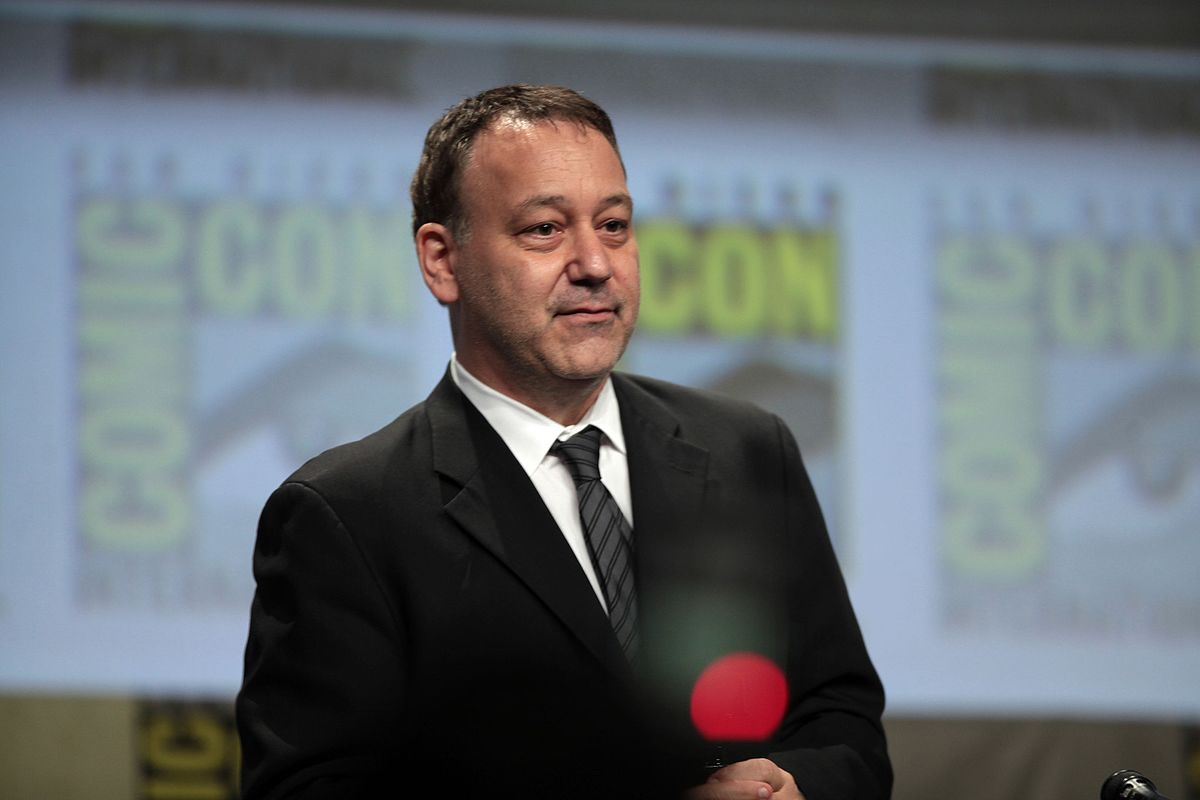Title of the work
Studio / Production Company
Country of the First Edition
Country/countries of popularity
Original Language
First Edition Date
First Edition Details
Hercules and the Circle of Fire. Directed by Doug Lefler; written by Christian Williams, Barry Pullman, Andrew Dettmann, and Daniel Truly. USA, (Universal) Action Pack Weds 8-10pm (syndicated television); 31 October 1994. 91 mins.
Running time
Format
Date of the First DVD or VHS
Genre
Action and adventure fiction
B films
Mythological fiction
Television series
Target Audience
Crossover
Cover

We are still trying to obtain permission for posting the original cover.
Author of the Entry:
Joel Gordon, University of Otago, joel_gordon@hotmail.co.nz
Peer-reviewer of the Entry:
Elizabeth Hale, University of New England, ehale@une.edu.au
Elzbieta Olechowska, University of Warsaw, elzbieta.olechowska@gmail.com

Sam Raimi by Gage Skidmore. Retrieved from Wikimedia Commons, licensed under CCBY-SA 2.0 (accessed: December 30, 2021).
Sam Raimi
, b. 1959
(Producer)
Sam Raimi is an American filmmaker, actor and producer. He was born in Michigan (USA), to a conservative Jewish family, and attended Michigan State University. His career has been closely linked with that of Robert Tapert. Although Raimi intended to major in English, he chose to put his studies on hold in order to work on the feature film The Evil Dead (1981), after the success of his first co-operative production with Robert Tapert, The Happy Valley Kid (1977). Raimi is a co-founder of both Renaissance Pictures and Ghost House Pictures (see above). His solo-directorial work (distinct from productions with Tapert) include the original Spider-man trilogy (2002–2007) starring Tobey Macquire, and, most recently, Oz the Great and Powerful (2013). His most recent solo-producer role was for the crime-thriller, Don’t Breathe (2016). As an actor, Raimi has appeared in many of his own films as minor characters – such as his cameo appearances in The Evil Dead and its sequels. Raimi turned to television during the 1990’s, working together with Tapert as a producer for the franchises Hercules: The Legendary Journeys, Xena: Warrior Princess, Young Hercules and Spartacus.
Bio prepared by Joel Gordon, University of Otago, joel_gordon@hotmail.co.nz

Robert Tapert by Cooltv. Retrieved from Wikipedia, licensed under CC0 (accessed: December 30, 2021).
Robert Tapert
, b. 1955
(Author, Producer)
Robert Tapert is an American actor, producer and writer. Born in Royal Oak, Michigan (USA), he attended Michigan State University where he first began experimenting with filmmaking under the influence of Sam Raimi. During this time, they both worked on the film The Happy Valley Kid (1977) in which Tapert also starred in the leading role. Following the success of this venture, the pair began work on their first feature film, The Evil Dead (1981) – directed by Sam Raimi and starring Bruce Campbell – and, in order to assist with its production, Tapert, Raimi and Campbell (along with Irvin Shapiro) co-founded Renaissance Pictures in 1979. This trio have since worked together on numerous successful films – particularly in the horror genre – including: Crimewave (1985), Easy Wheels (1989), Darkman (1990), Lunatics: A Love Story (1991), Timecop (1994), 30 Days of Night (2007) and The Gift (2015). In 2002 Tapert and Raimi co-founded Ghost House Pictures known for, among others, the film franchises The Grudge (2004, 2006, 2009) and Bogeyman (2005, 2007, 2008). Tapert’s involvement in television began during the 1990’s with his most notable productions being the franchises of Hercules: The Legendary Journeys (1995-1999), Xena: Warrior Princess (1995–2001) and Young Hercules (1998–1999) – all of which included both direct-to-television movies and television serials spanning several seasons. It was during this period – in 1998 – that Tapert married New Zealand actress Lucy Lawless (the star of Xena), with whom he has since had two children. More recently, his interest in antiquity and television has returned with the serials Spartacus: Blood and Sand (2010), Spartacus: Gods of the Arena (2011), Spartacus: Vengeance (2012) and Spartacus: War of the Damned (2013) and plans for a Xena reboot for NBC. (see further, his official website, accessed: August 16, 2019).
Bio prepared by Joel Gordon, University of Otago, joel_gordon@hotmail.co.nz

Christian Williams by Pacunagonz. Retrieved from Wikimedia Commons, licensed under CC BY-SA 4.0 (accessed: December 30, 2021).
Christian Williams
, b. 1943
(Author, Producer)
Christian Williams is an American journalist and television writer from Brooklyn, New York. His career in the news industry began in 1972 as an assistant editor (Style Section) for The Washington Post. It was during his early years at the Post that Williams was given a unique insight into the film/television industry, serving as the editor on a behind-the-scenes exclusive when Robert Redford used the Post’s newsroom to research his film All the President’s Men (1976). In 1984 Williams became a reporter in Bob Woodward’s investigative team which led to his second interaction with the film/television industry: in 1986 Woodward’s team (Woodward, Williams and co-journalist Richard Harwood) wrote and featured in an ABC movie, Under Siege, which was based upon the group’s reporting on domestic terrorism. Williams then continued to dabble in the television industry, co-writing (alongside Woodward) an episode of the television drama series Hill Street Blues (1981–1987), before formally leaving journalism for a career as a television writer – specializing in one-hour drama television shows. He went on to co-create (alongside David Milch) the drama Capital News (1990) before assisting in the creation of Hercules: The Legendary Journeys franchise (which began with the five direct-to-television films). Unlike Tapert and Raimi, however, Williams was not directly involved in the production of the Hercules: The Legendary Journeys serial beyond the pilot films. Williams went on to continue writing for television, for example as the co-executive producer of the drama Six Feet Under (2001–2005), until he retired in 2010. He has since turned his interests to authoring books and sailing.
Bio prepared by Joel Gordon, University of Otago, joel_gordon@hotmail.co.nz
Casting
Hercules: Kevin Sorbo,
Zeus: Anthony Quinn,
Deianeira (Hercules’ wife): Tawny Kitaen,
Chiron: Kevin Atkinson,
Prometheus: Mark Ferguson,
Iole: Marley Shelton,
Nessus: Cliff Curtis,
Mintoaur: Anthony Ray Parker.
Adaptations
Novel series:
John Whitman (1998) Hercules: The Legendary Journeys. San Francisco: CA: Chronicle Books. (see entry) [Hercules and the Amazon Women; Hercules and the Circle of Fire; and “The Wrong Path” – S1E1]
Summary
This film takes inspiration from several mythological themes, such as Prometheus providing fire for mankind and the wounding of Chiron (with Hydra blood) by Hercules, and combines these into a largely unique narrative.
The film opens with Hercules, plagued with premonitions that the world will be covered in ice, on a quest to defeat a witch who has (apparently) been sapping the life force of the local men. Hercules follows a young man into the witch’s cave but becomes suspicious that all is not as it seems. The young man then reveals himself to be a warlock (and the ‘witch’ his prisoner) who traps Hercules and almost bests the hero until Hercules discovers that the warlock’s heart is hiding nearby. Upon defeating the warlock Hercules fills up a vial with water from the lair’s fountain and, when Zeus appears, he dismisses the god explaining that a friend urgently requires his help.
Hercules is referring to the centaur Chiron who is suffering from an incurable wound and to whom Hercules gives the vial of water. Although initially healing the wound, this only provides temporary relief and a miserable Chiron expresses his anguish at being immortal: he is unable to die and will now have to suffer for all eternity, and he will have to witness his wife and children grow old and die without him.
Meanwhile, Hercules’ premonitions are becoming reality as fires are being extinguished all over the world. At the nearby temple to Hera, within is the only remaining source of fire, the beautiful woman from the cave attempts to bargain with a priestess until Hercules arrives and uses brute force to enter and light the woman’s torch. Thankful the woman introduces herself as Deianeira (a different Deianeira from Hercules and the Lost Kingdom) but the victory is momentary – the priestess of Hera reveals that Hera, sick of mankind, has stolen the Eternal Torch (the source of all fire) without which humanity will die. Under Chiron’s instruction, Deianira and Hercules set off to find Prometheus who directs them, in turn, to Mount Aepion.
Upon arriving at the Mount, Hercules walks across the snow just like in his dream. Zeus appears and Hercules confronts the god about why he has not done more to helped mankind. Zeus reveals that Hera has placed the Eternal torch within a ring of fire which has the power to kill immortals. Zeus tries to prevent Hercules from getting the torch back, claiming that he loves Hercules more than he loves mankind and that he is not willing to risk his son’s life. Hercules, however, cannot be swayed and successfully retrieves the torch and returns fire to mankind by throwing it into Prometheus’ home. As Hercules lays dying within the circle, Zeus begs Hera to relent – which she does. As Hercules leaves the Mount, he lights a torch from the flames which he takes back to Chiron and burns away the centaur’s immortality, healing him of his wound.
Analysis
Of all the five pilot-films, Hercules and the Circle of Fire draws most clearly upon traditional fantasy elements as well as mythological material.
Regarding the latter, the film adapts the titan Prometheus’ traditional association with having ‘stolen’/provided fire for mankind after it had been taken away by Zeus (Hesiod Theogony and Works and Days) – the consequences for which were Pandora and her ‘box’. In the Works and Days, Hesiod notes that by removing fire, Zeus took away the ‘means of life’ for mankind. While this connection between life and fire (and its removal) is maintained by the films version of events, it is the doing of Hera – the franchise’s primary antagonist – rather than Zeus (for the god’s ‘traditional role’ jars strongly with his characterisation as a champion of mankind and as a loving father of Hercules). Further, there is no mention of Pandora and her ‘punishment’ as a consequence for the return of fire (which also would make little sense since Zeus wants mankind to thrive).
Likewise, the wounding of Chiron finds a basis within ancient myth. Chiron is a particularly famous centaur from Greek mythology having tutored several of the most prominent Greek heroes: e.g. Jason, Asclepius, and Achilles – to name a few examples. In addition, Chiron was famous for his wisdom and as a healer. He was also an exceptional centaur in that, while not the only of his kind, he was the half-brother of Zeus (both being sons of Cronos) and thus he was immortal. According to myth, Hercules accidentally wounded Chiron with an arrow dipped in hydra-blood when fighting against the centaurs. The pain was insufferable and so Chiron relinquished his immortality to Zeus but, as compensation, the god made him into a constellation (Sagittarius/Centaurus). While the majority of the myth’s components are retained by the film, there are two notable points of contrast: (1) Chiron is now also the tutor of Hercules (who taught him as a boy at the ‘academy – see Young Hercules entry); (2) Chiron does not die at the end of the film (although he still looses his immortality) and this is due to the actions of Hercules rather than Zeus (as appropriate given that he, rather than the god, is the films’ primary protagonist). The inclusion of this myth here is likely due to the popularity that it has received in recent times through the concept of the “wounded healer” made famous by the psychologist Carl Jung (Jung interpreted the myth as revealing an empathetic connection experienced by doctors and other healing professions via their patients’ experiences).
The most notable ‘intrusion’ of fantasy elements in the film occurs early on with the prominence of witches and warlocks. While the ancient Greeks and Romans were not unfamiliar with the concept of witches, early depictions of such figures were focused as much on the female’s potent sexuality which went hand in hand with their practice of witchcraft: e.g. Circe’s relationship with Odysseus provided an obstacle to his return home to Penelope and the fact that she was able to turn his men into swine is largely secondary (Homer’s Odyssey); while Medea’s relationship with Jason proved problematic for his desire to have legitimate heirs (most notably in Euripides’ Medea). The depiction of witches as ‘ugly hags’ thus takes its inspiration from European folklore, rather than antiquity. A further illustration of association of the practice of witchcraft with feminine figures is found in the fact that warlocks (male ‘witches’) were largely unknown during antiquity. Males tended to be more readily associated with the labels of magos or goēs but these were far broader categorisations which included all kinds of esoteric knowledge (astrology, alchemy etc) and practitioners of the Zoroastrian religion. Figures such as Orpheus, Pythagoras and Empedocles were associated with the practice of magic, but they were also philosophers (of a sort) and thus were considerably closer to wise sages than warlocks.
Another modern/fantasy element is the trope of dying gods. According to the film, the circle of fire has the ability to kill a god by removing their immortality and thus Zeus is unable to act against Hera and Hercules’ own life is in jeopardy when he chooses to intervene. However, this presentation of immortality is the antithesis of what the ancients understood divinity to entail: deicide was an entirely foreign concept to the ancients. Divine nature demanded that the gods be literally “undying” (a-thanatos) with the primary example of this being the Iliadic episode of Aphrodite’s wounding by Diomedes in the Iliad (book 5): Dione presents three mythic paradigms which each emphasize that while a god can suffer, they cannot die (the imprisonment of Ares; Hercules’ wounding of Hera; Hercules’ wounding of Hades). The adaptation of this traditional understanding of immorality/divinity first occurred in the critiques of paganism by the early Church fathers which then went on to greatly influence the development of western culture. In consequence, deicide and dying gods have now become a common trope within popular culture.
Further Reading
Baker, E., “Harlots and Harlots: A Comparison of the Amazon Tribes Shown in Hercules and the Amazon Women and Xena: Warrior Princess.” Whoosh! 12 (1997) (IAXS Research Project #327), www.whoosh.org (accessed January 25, 2018).
Blondell, R., “How to kill an Amazon”, Helios 32.2 (2005): 183–213.
Blondell, R., “Hercules Psychotherapist” in W. Haslem, A. Ndalianis, C. J. Mackie, eds., Super/Heroes: from Hercules to Superman, New Academia Publishing, 2007, 239–249.
Drushel, B., “Pandora's box in cyberspace: The online alternative fan sites of Hercules: The Legendary Journeys” Femspec 7.2 (2006): 7–28.
Solomon, J., “The Convergence of Family Values, Computer-Generated Monsters, and Cleavage in Hercules: The Legendary Journeys”, in A. Blanshard, E. Stafford, eds., The Modern Hercules vol. 2., forthcoming.
Weisbrot, R., Hercules: The Legendary Journeys – an insider’s guide, Taylor Trade Publications, 2004.
Wright, A., "Classical myths and legendary journeys: Hercules, landscape, identity and New Zealand", Australasian Journal of Popular Culture 2.3 (2013): 351–362.
Addenda
Director: Josh Becker.
Writers: Andrew Dettmann and Daniel Truly.


